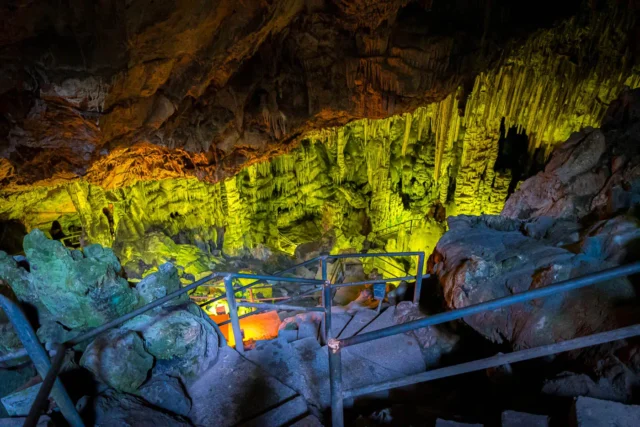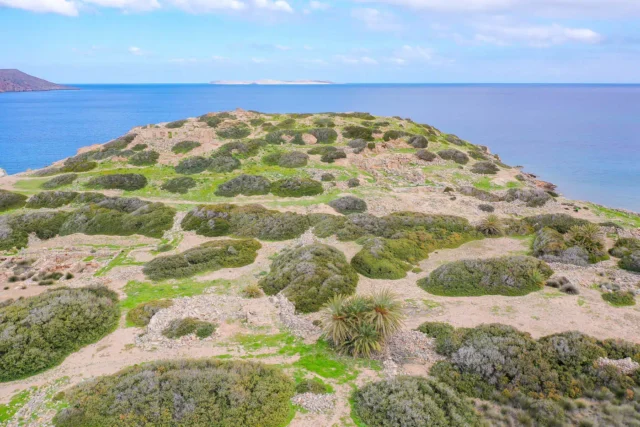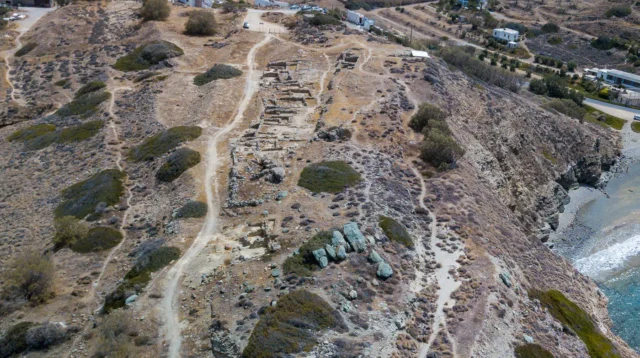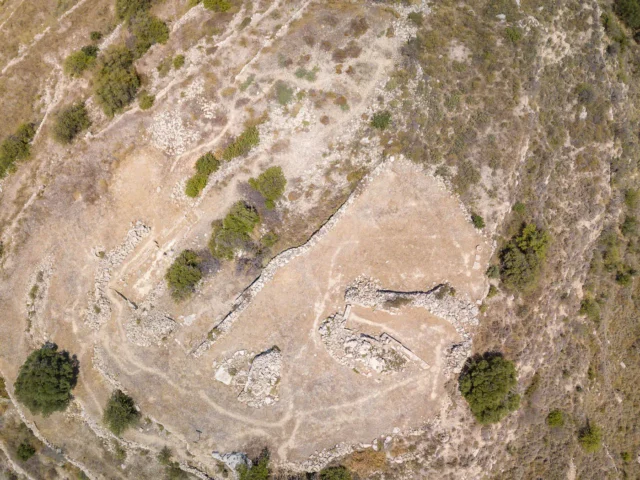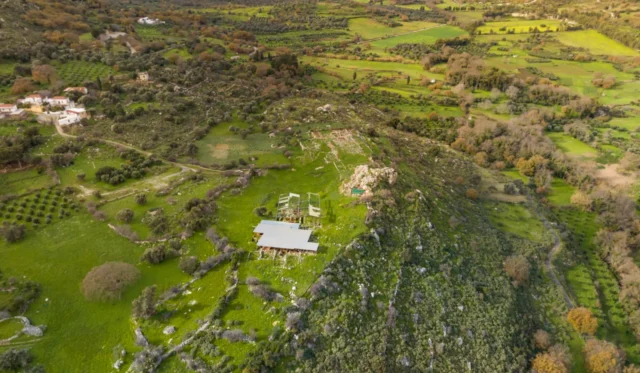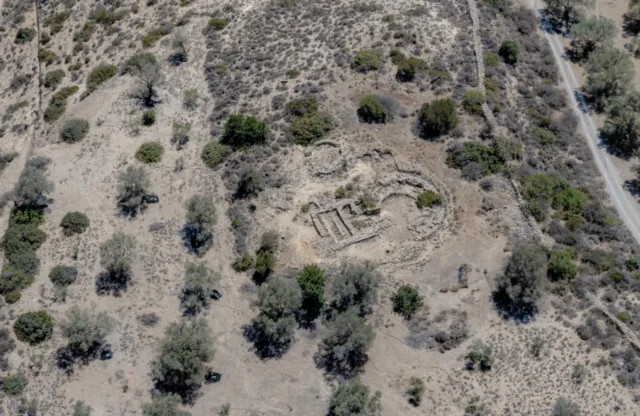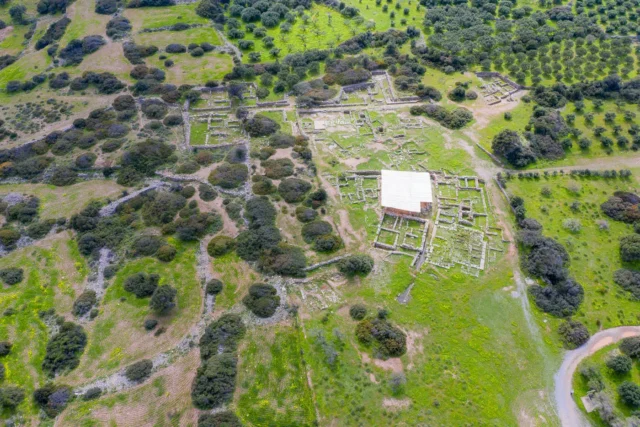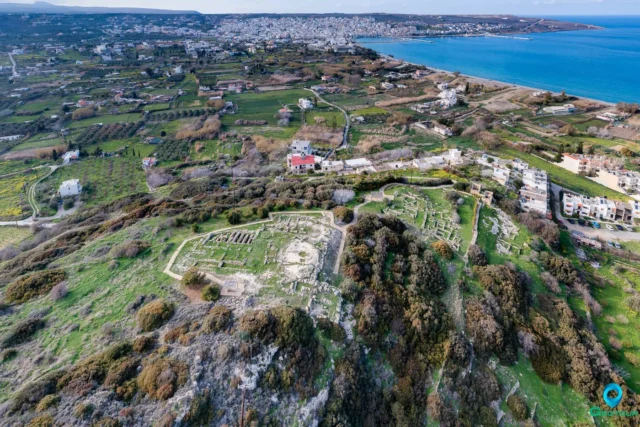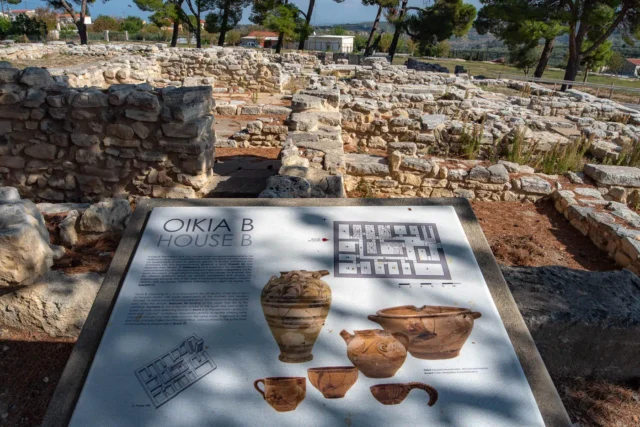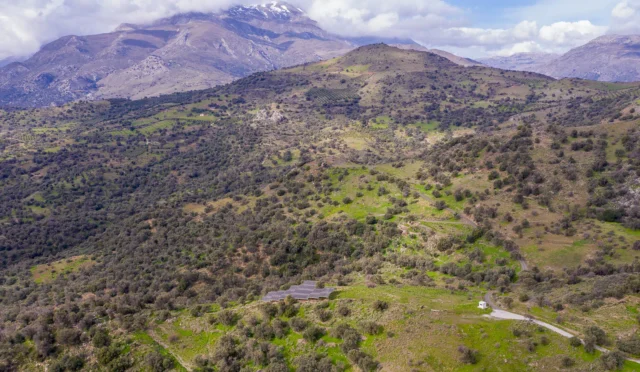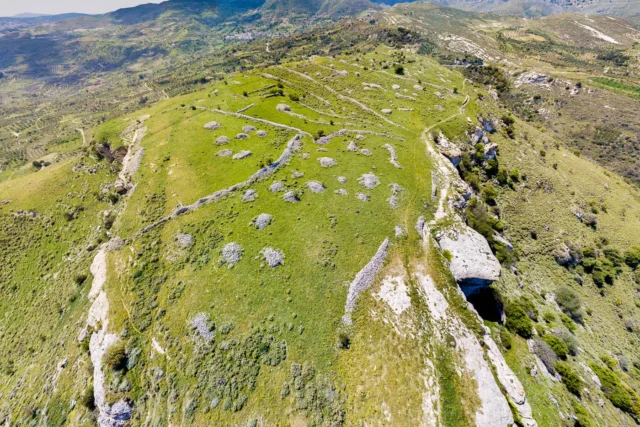107
listings found
Categories
Active filters:
Dikteon Antron cave
Dikteon Antron, also known as Psychro Cave, is a site of significant mythological and archaeological importance located on Mount Dikti in Crete.
The cave's history spans from the Neolithic to the Roman period, primarily as a religious site. In Greek mythology, it is renowned as the birthplace of Zeus.
The cave's interior features a wealth of stalactites and stalagmites, as well as a lake. Archaeological excavations have uncovered artifacts from various periods, attesting to its continuous use by humans. Open to the public, visitors can explore the cave's chambers and witness its geological formations.
Ancient Itanos
Ancient Itanos, a prominent harbor city on Crete's northeastern coast, thrived on trade and cultural exchange. Its strategic location in the eastern Mediterranean facilitated its growth and influence over eastern Crete. The city, built across two adjacent hills, likely housed important sanctuaries. The city center, located between these acropoleis, contains partially excavated building remains. Two additional hills mark the northern and southern boundaries of the city, with the northern hill housing the necropolis and the southern hill featuring defensive walls and towers.
Itanos held a unique position among Cretan cities due to its outward-looking nature and focus on trade. The city prospered well into the Roman period, even minting its own coins. The Northern Necropolis served as the main burial ground, with excavations revealing its use from the late Geometric to the late Hellenistic period. Notable artifacts recovered from Itanos include a marble funerary stele depicting a warrior, now housed in the Agios Nikolaos Museum, and an Ionic capital made of ironstone, suggesting the presence of monumental structures.
Chamezi archaeological site
An archaeological site near Sitia in eastern Crete, known for its unique elliptical house from the Middle Minoan IA period. Discovered in 1903 by Stephanos Xanthoudides and later studied by Costis Davaras, the structure was initially thought to be a peak sanctuary but is now considered a domestic dwelling. The site also contains earlier rural farmhouses from the Early Minoan period. Key features include a central courtyard, a possible domestic shrine where figurines were found, and numerous bronze artifacts.
Trypitos Hellenistic settlement
Located on a promontory 1.5km east of modern Sitia, this site was a small, fortified town that flourished during the Hellenistic period (late 3rd to mid-2nd century BC). Possibly the ancient city of Setaia or Heteia, its strategic position offered natural defenses and access to two harbors. Excavations revealed a well-preserved naval shelter (neosoikos), indicating maritime trade. The discovery of coins marked "ΠΟ" suggests it might be Polichna, an autonomous city-state with its own mint. Its relationship with nearby sites like Petras is still researched. The city likely declined after the mid-2nd century BCE, though its later history is uncertain. It remains an active archaeological site under investigation.
Agia Fotia Minoan Tombs
Minoan Tombs at Agia Fotia, Crete Historical Significance Near the modern village of Agia Fotia, on the northeastern coast of Crete, lies an extensive Minoan cemetery dating to the Early […]
Presos (Praisos) ancient settlement
Located in eastern Crete's Siteia peninsula, this significant archaeological site occupies two hills near the Siteia river. It was a major settlement from the Late Minoan through Hellenistic periods, notably associated with the Eteocretans, considered the original Cretans. Evidence dates back to the Neolithic. Key periods include Late Minoan (tombs, refuge settlements), Archaic (city-state formation, Eteocretan inscriptions), Classical (flourishing inland city-state controlling territory), and Hellenistic (destruction by Hierapytna around 140 BCE). The site saw reoccupation in the Middle Byzantine and Venetian periods. Archaeological finds include Eteocretan inscriptions, LM III tombs, Archaic sanctuaries (Altar Hill), architectural remains (houses, possible Andreion), pottery, and pithoi. The distinct Eteocretan language and identity are crucial aspects. The city lacked walls but had a nearby fort. Agriculture and textile production were likely economic activities.
Monastiraki Minoan Palace
Situated in Crete's Amari Valley, a strategic corridor, this site was a significant Minoan Protopalatial administrative center (c. 2100-1700 BC). Covering over 300,000 square meters, it includes large-scale buildings, vast storage areas, workshops, and multiple sealings archives that reveal its economic power. Artifacts, including sealings, show a deep integration into the broader Minoan trade network, with notable connections to the palace at Phaistos.
Minoan Archaeological Site at Odigitria Monastery
The Odigitria Cemetery in Crete's Asterousia mountains is an archaeological site dating back to the Early Minoan (EM) period.
It features two tholos tombs (A and B), a Rectangular Building, courtyards, an ossuary, and a possible altar, all enclosed within a peribolos wall. The site's three construction phases span from the Final Neolithic to the Middle Minoan (MM) era. Tholos A, the smaller of the two tombs, contained undisturbed EM I pottery, while Tholos B boasts a unique complete outer wall. The Rectangular Building may have served as an independent burial building or ritual space. The courtyards, particularly the Eastern and Outer Courtyards, likely hosted rituals associated with the deceased. The ossuary reveals the practice of secondary burial, where bodies were initially interred in the tholos tombs or pithoi and later transferred to the ossuary. The Odigitria Cemetery provides significant insights into Early and Middle Minoan burial practices, social structures, and material culture.
Apesokari Tholos tombs
The Apesokari Tholos Tombs in Crete are significant Early Minoan burial sites. Tholos Tomb A features a unique circular burial chamber and annex, used for both primary and secondary burials. Tholos Tomb B includes multiple rooms with evidence of communal drinking and larnax burials. Both tombs offer valuable insights into Early Minoan funerary practices and social organization.
Palaikastro Minoan Settlement (Roussolakkos)
The Minoan settlement of Palaikastro, located near the modern village of Palaikastro on Crete's eastern coast, thrived during the Bronze Age. Occupied from the Early Minoan II to the Late Minoan IIIB periods (c. 2600-1200 BC), the settlement spanned over 50,000 square meters. Palaikastro's strategic location with a sheltered harbor facilitated trade and agriculture. Excavations have revealed a well-planned town with houses, workshops, and evidence of a vibrant social and economic life. The town's layout suggests central planning, with grid-like streets and organized blocks of houses, possibly indicating a clan-based social structure. Palaikastro's economy was based on agriculture, trade, and crafts like weaving, metalworking, and pottery production. Religious practices are evident through artifacts like figurines and incense burners. Ongoing archaeological investigations continue to enrich our understanding of this important Minoan center.
Petras Minoan settlement
Located near Siteia in eastern Crete, this significant Minoan archaeological site shows continuous occupation from Final Neolithic (ca. 4000 BCE) to Byzantine eras. Excavations reveal a small palace, first built in MM IIA, destroyed around 1700 BCE (MM IIB), rebuilt in Neopalatial (MM III-LM IB), and destroyed again in LM IB. Features include a central court, magazines, ashlar masonry, and the best-preserved Minoan hieroglyphic archive. A few Linear A inscriptions were also found. The palace was the center of an urban settlement with houses, evidence of pottery, textile, and purple dye production, and Protopalatial/LM III fortifications. Limited Postpalatial (LM III) reoccupation occurred. The site offers key insights into Minoan regional administration and economy in eastern Crete.
Zakros Minoan Palace
The Minoan Palace of Zakros, situated in eastern Crete, features Neolithic habitation and a significant Late Minoan IB palace. Excavations reveal a Neopalatial settlement, Protopalatial houses, and evidence of post-palatial reoccupation. The palace, with 150 rooms and a central court, highlights Minoan architectural conventions. Discoveries include clay nodules, seal impressions, and elaborate artifacts like the "Bull’s Head Rhyton." The site’s history spans from the Final Neolithic to the Late Minoan IIIB periods, marked by both construction and destruction, potentially by natural disasters. Excavations by Hogarth and Platon uncovered residential and economic zones, a complex street network, and palatial annexes. The site, lacking modern visitor facilities, offers insights into Minoan civilization, with artifacts exhibited in Heraklion, Aghios Nikolaos, and Siteia museums.
Knossos archaeological site
The Palace of Knossos, located on the Kephala hill south of Heraklion, Crete, is an important site of the ancient Minoan civilization. Occupied since around 7000 BCE during the Aceramic Neolithic period. The First Palace, built during the Middle Minoan IB-IIA period, represents a significant shift in Minoan society from a clan-based structure to a hierarchical one. This monumental building, covering nearly 10,000 square meters on the ground floor alone, served as a hub for administrative, storage, and cult activities. The First Palace also introduced innovative features like storage magazines, showcasing the society's wealth and resources. The New Palace emerged after a massive earthquake that occurred at the end of the Middle Minoan IIIA period, the palace underwent major reconstruction in the Middle Minoan IIIB period. Around 1450 BCE, widespread destruction occurred across Crete, affecting palaces and settlements. While Knossos suffered damage, it wasn't destroyed like other palaces. This period saw the introduction of Linear B, an early form of Greek script used by the Mycenaeans, suggesting their presence at Knossos. The final destruction of the palace, possibly in Late Minoan IIIA2 (1325-1300 BCE), left it deserted, but the town continued to exist. Knossos continued to be inhabited during the Classical, Hellenistic and Roman periods. Two basilicas from the First Byzantine period indicate that the city was still active during this time. Knossos appears to have followed the fate of other urban centers in Crete and declined early.
Malia Minoan Palace
The Minoan archaeological site at Malia, located on the northern coast of Crete, is a significant site for understanding the Bronze Age civilization. The Palace of Malia is the third largest Minoan palace discovered. The palace and surrounding town and cemeteries offer a glimpse into the complex social, political, economic, and religious structures of Minoan society. The area was inhabited as early as the Early Neolithic period. The first monumental architecture at Malia, often referred to as the Old Palace, dates to the Early Minoan IIB period. This structure, or group of structures, was built around a large open space, sharing the same alignment as the later palace. The second palace, whose ruins are visible today, was built in the Late Minoan IA period, around 1650 BCE. It was constructed on the ruins of the Old Palace, inheriting its basic layout and orientation. The palace's central court, a defining feature of Minoan architecture, is oriented north-south. The New Palace at Malia met its demise around 1450 BCE, coinciding with the destruction of other Minoan sites across Crete. The cause of this widespread destruction remains a topic of scholarly debate.
Ancient Tylissos
Tylissos, an ancient Minoan town located on the slopes of Mount Psiloritis in Crete, thrived between 1650 and 1200 BC. The town's strategic location on a major Minoan road contributed to its prosperity. Excavations have revealed three grand palaces (Megaron A, B, and C), showcasing remarkable Minoan architecture. Megaron A, the best-preserved, features a central courtyard, apartments, and storage rooms.
Significant finds include bronze cauldrons, a bronze figurine, Linear A tablets, and miniature frescoes comparable to those found in Knossos. These discoveries suggest Tylissos was a center for bronze working and played an important role in the Minoan civilization. Numerous tombs dating back to 1400-1200 BC have also been unearthed, containing painted sarcophagi, vases, jewelry, and seals, offering further insights into Minoan burial practices and culture.
Minoan villa in Apodoulou
An archaeological site in Amari, 20km from Phaistos, significant during the Protopalatial period (1900-1700 BCE). Positioned on a strategic route to the north coast, initial work by Spiros Marinatos in 1934 and later by Louis Godart revealed a complex destroyed by earthquake and fire. Excavated buildings (A-G) include residential quarters, workshops, and kitchens. Block A was a central hub for storage and administration, confirmed by numerous pithoi and sealings identical to those found at Phaistos.
Ancient Rizinia
Rhizenia, also known as Prinias, was a city in central Crete during the Late Minoan IIIC period (around 1200 BC). Located on the Patela plateau, it held a strategic position overlooking key communication routes. Rhizenia likely played a crucial role in the region's political and economic landscape. The necropolis of Siderospilia has revealed much about burial practices and social structures of the time. The city's political system was unique, possibly incorporating both aristocratic and democratic elements. Archaeological investigations have revealed insights into urban layout, religious practices, and daily life. Imported artifacts from Cyprus and Egypt underscore Rhizenia's integration into a wider network of exchange during the Early Iron Age.
Minoan Shipyard at Agii Theodori
The Minoan civilization on Bronze Age Crete heavily relied on maritime prowess, establishing extensive Mediterranean trade networks with Egypt, Cyprus, and the Levant through advanced shipbuilding and strategic harbor towns. The archaeological site at Agii Theodori, on Vathianos Kambos beach near Heraklion, exemplifies this. Dating to the Late Minoan I period (c. 1600-1450 BC), it features a significant, carved dry dock (approx. 48m x 11m) and timber storage areas, indicating a dedicated shipyard. Its peninsula location offered protection and sea access. This site, near the Palace of Knossos and the port of Amnisos, underscores Minoan maritime dominance, shipbuilding ingenuity, and the vital role of coastal settlements in their economic and cultural expansion.
Minoan Palace of Epano Archanes
The Minoan Palace of Epano Archanes, also known as the Tourkogeitonia Palace, is a significant archaeological site located in the village of Epano Archanes on the island of Crete, Greece. This palatial complex dates back to the Neopalatial period of the Minoan civilization (around 1700-1450 BC). It is smaller than the palaces of Knossos, Phaistos, and Malia, but boasts a unique architectural layout with multiple wings and levels, and impressive features including an elaborate drainage system. The palace likely played a crucial role in the economic and religious life of the surrounding community. Excavations at the site have unearthed a wealth of artifacts, including pottery, tools, figurines, and seal stones, shedding light on the daily life, artistic traditions, and religious practices of the Minoans. A recent discovery in 2024 unearthed a unique Gate Shrine located outside the main entrance, the first of its kind at a Minoan palace, shedding new light on the religious practices and beliefs of this ancient civilization.
Anemospilia
Anemospilia, a Minoan archaeological site on Mount Juktas in Crete, offers a unique glimpse into Minoan religious practices and beliefs. Discovered in 1979, the site features a rectangular building with four rooms, destroyed by an earthquake in the 17th century BC. The eastern chamber contains remnants of a stepped altar with offerings, fragments of pithoi with traces of food, and reconstructed vessels depicting religious ceremonies. The vestibule housed a crushed skeleton and numerous vessels. The central chamber contains a stone altar, believed to be the base of a life-sized wooden statue, with traces of vessels and a box containing a piece of rock symbolizing the earth. The western chamber contained three skeletons, including a young man found on a platform with a decorated knife, leading to interpretations of human sacrifice.









